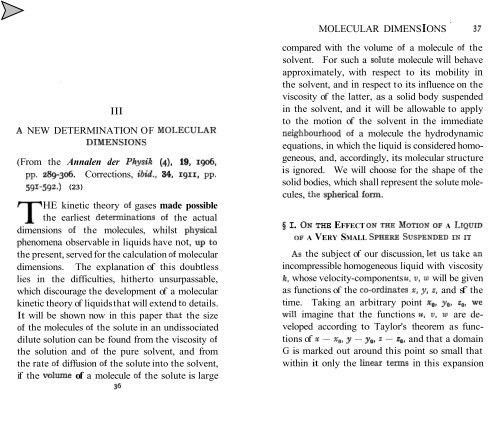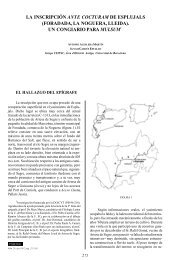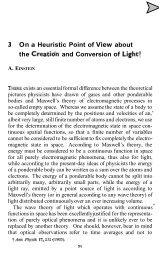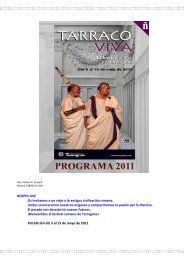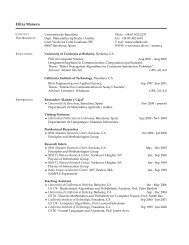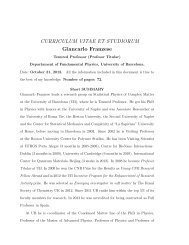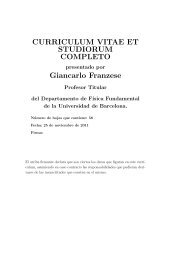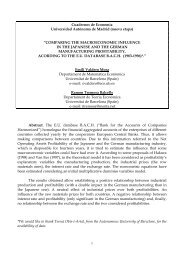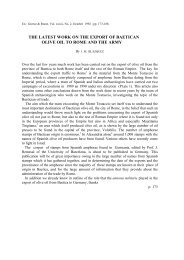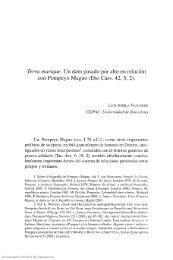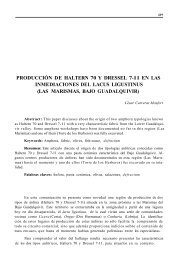MOLECULAR DIMENSIONS ' III A NEW DETERMINATION OF ...
MOLECULAR DIMENSIONS ' III A NEW DETERMINATION OF ...
MOLECULAR DIMENSIONS ' III A NEW DETERMINATION OF ...
Create successful ePaper yourself
Turn your PDF publications into a flip-book with our unique Google optimized e-Paper software.
<strong>MOLECULAR</strong> <strong>DIMENSIONS</strong> ' 37<strong>III</strong>A <strong>NEW</strong> <strong>DETERMINATION</strong> <strong>OF</strong> <strong>MOLECULAR</strong><strong>DIMENSIONS</strong>(From the Annalen der Physik (4), 19, 1906,pp. 289-306. Corrections, ibid., 34, 1911, pp.591-5922.] (23)THE kinetic theory of gases made possiblethe earliest determinations of the actualdimensions of the molecules, whilst physicalphenomena observable in liquids have not, up tothe present, served for the calculation of moleculardimensions. The explanation of this doubtlesslies in the difficulties, hitherto unsurpassable,which discourage the development of a molecularkinetic theory of liquids that will extend tb details.It will be shown now in this paper that the sizeof the molecules of the solute in an undissociateddilute solution can be found from the viscosity ofthe solution and of the pure solvent, and fromthe rate of diffusion of the solute into the solvent,if the volume of a molecule of the solute is large36compared with the volume of a molecule of thesolvent. For such a sofute molecule will behaveapproximately, with respect to its mobility inthe solvent, and in respect to its influence on theviscosity of the latter, as a solid body suspendedin the solvent, and it will be allowable to applyto the motion of the solvent in the immediateneighbourhood of a molecule the hydrodynamicequations, in which the liquid is considered homogeneous,and, accordingly, its molecular structureis ignored. We will choose for the shape of thesolid bodies, which shall represent the solute molecules,the sphericdi fom-*I. ON THE EFFECT ON THE MoTroN <strong>OF</strong> A 1,IQWID<strong>OF</strong> A VERY SMALL SPHERE SUSPENDED IN ITAs the subject of our discussion, Iet us take anincompressible homogeneous liquid with viscosityK, whose velocity-components W, V, W will be givenas functions of the Co-ordinates x, y, x, and sf thetime. Taking an arbitrary point go, yo, x,, wewifl imagine that the functions u, V, W are developedaccording to Taylor's theorem as functionsof x - x,, y - yo, x - x,, and that a domainG is marked out around this point so small thatwithin it only the linear terns in this expansion
38 THEORY <strong>OF</strong> BROWNIAN MOVEMENThave to be considered. The motion of the liquidcontained in G can then be looked upon in thefamiliar manner as the result of the superpositionof three motions, namely,I. A parallel displacement of all the particles'of the liquid without change of theirrelative position.2. A rotation of the liquid without change ofthe relative position of the particles ofthe liquid.3. A movement of dilatation in three directionsat sight angles to one another (the principalaxes sf ation^^ ion^^We wif€ imagine now a. spherical rigid body inthe domain G, whose centre lies at the pointyo, x,, and whose ~~~e~~~~~~ are very small comparedwith those or" the domain G, We willfurther assume that the motion under c~nsiderationis so shw that the kinetic energy of thesphere is negligible as we11 as that of the liquid.It will be further assumed that the velocity componentsof an element of sudace the sphereshow agreement with the corresponding velocitycomponents of the particles of the liquid in theimmediate neighbourhood, that is, that the contactlayer(thought of as continuous) also exhibits<strong>MOLECULAR</strong> <strong>DIMENSIONS</strong> 39everywhere a viscosity-coefficient that is notvanishingly small.It is clear without further discussion that thesphere simply shares in the partid motions I and 2,without modifying the motion of the neigkibouringliquid, since the liquid moves as a rigid body inthese partial motions ; and that we have ignoredthe effects of inertia.But the motion 3 will be modified by the presenceof the sphere, and our next problem will beto investigate the influence of the sphere on thismotion of the liquid. We will further refer themotion 3 to a co-ordinate system whose axes areparallel to the principal axes of dilatation, and wewill putx - x, = Q:Y - YO = T',x-z, = 5,then the motion can be expressed by the equationsII)uQ == ' f fV0 = Bq,q.J a ,in the case when the sphere is not present.A, B, C are constants which, on account of theincompressibility of the liquid, must fulfil thecondition(2) A+B+C=0 * (24)
40 THEORY <strong>OF</strong> BROWNIAN MOVEMENTNow, if the rigid sphere with radius P is introducedat the point x,, yo, q,, the motions of theliquid in its neighbourhood are modified. In thefoliowing discussion we will, for the sake of convenience,speak of €’ as “ finite ” ; whilst thevalues of 6, 9, 5, for which the motions of theliquid are no longer appreciably influenced by thesphere, we will speak of as “ infinitely great.”Firstly, it is clear from the symmetry of themotions of the liquid under consideration thatthere can be neither a translation nor a rotationof the sphere accompanying the motion in question,and we obtain the limiting conditionsu=v==w=owhenp=Pwhere we have putp = JP 3- ?I2 4- P > 0.Here u, V, w are the velocity-components of themotion now under consideration (modified b~7 thesphere). If we puta4 = 4 3- u,,(3) = Br] 4- v1,W = cg + wi,’ since the motion defined by equation (3) must betransformed into that defined by equations (I)in the “ infinite” region, the velocities ul, V,, wlwill vanish in the latter region.<strong>MOLECULAR</strong> <strong>DIMENSIONS</strong> 41The functions u, V, W must satisfy the hydrodynamicequations with due reference to theviscosity, and ignoring inertia. Accordingly, thefollowing equations will hold :- (*)where A stands for the operator-+-+-32 3%3e2 392 352and 9 for the hydrostatic pressure.Since the equations (I) are solutions of theequations (4) and the latter are linear, accordingto (3) the quantities u,, V,, w1 must also satisfy theequations (4). I have determined u,, V,, q , and P,according to a method given in the lecture ofKirchhoff quoted in $4 (t), and find(*) G. Kirchhoff, “ Lectures on Mechanics,” Lect. 26.(tj ‘‘ From the equations (4) it follows that ap = o,If p is chosen in accordance with this condition, and afunction V is determined which satisfies the equationAV = ;P,then the equations (4) are satisfied if we putand chose u’, V’,AW’ = o, andW‘, so that Au’ = o, Av’ = o, and
42 THEORY <strong>OF</strong> BROWNIAN MOVEMENT<strong>MOLECULAR</strong> <strong>DIMENSIONS</strong> 43where(5a)Now if we putand in agreement with thisIt is easy to see that the equations (5) are solutionsof the equations (4). Then, sinceandwe getAt = o, A- = o,PI 2Ap=PA($) = - ${A(;)} = o,andthe constants a, b, e can be chosen SO that when p P,= W = W = O. By superposition of three similarsolutions we obtain the solution given in the equations(5) and W *But the last expression obtained is, according tothe first of the equations (S), identical with dpldE.In similar manner, we can show that the second
44 THEORY <strong>OF</strong> BROWNIAN MOVEMENTand third of the equations (4) are satisfied. Weobtain further-But since, according to equation (sa),it' follows that the last of the equations (4) issatisfied. As for the boundary conditions, ourequations for zd, V, W are transformed into theequations (I) only when p is indefinitely large.By inserting the value of D from the equajion(sa) in the second of the equations (5) we getWe know that u vanishes when p = P. On thegrounds of syrnmetry the same holds for V and W.We have now demonstrated that in the equations(5) a solution has been obtained to satisfy both<strong>MOLECULAR</strong> <strong>DIMENSIONS</strong> 45the equations (4) and the boundary conditions ofthe problem.It can also be shown that the equations (5) arethe only solutions of the equations (4) consistentwith the boundary conditions of the problem.The proof will only be indicated here. Supposethat, in a finite space, the velocity-components ofa liquid u, V, W satisfy the equations (4).Now, ifanother solution U, V, W of the equations (4) canexist, in which on the boundaries of the sphere inquestion U = zc, V = V, W = W, then (U - u,V - V, W - W) will be a solution of the equations(4), in which the velocity-components vanishat the boundaries of the space. Accordingly, nomechanical work, can be done on the liquid containedin the space in question. Since we haveignored the kinetic energy of the liquid, it followsthat the work transformed into heat in the spacein question is likewise equal to zero. Hence weinfer that in the whole space we must have zc = u',ZI = V', W = W', if the space is bounded, at leastin part, by stationary walls. By crossing theboundaries, this result can also be extended tothe case when the space in question is infinite, asin the case considered above. We can show thusthat the solution obtained above is the solesolution of the problem.
46 THEORY <strong>OF</strong> BROWNIAN MOVEMENTWe will now place around the point x,, yo, x, asphere of radius R, where R is indefinitely largecompared with P, and will calculate the energywhich is transformed into heat (per unit of time)in the liquid lying within the sphere. This energyW is equal to the mechanical work done on theliquid. If we call the components of the pressureexerted on the surface of the sphere of radius R,Xn, Yn, 2%) thenwhere ,the integration is extended over the surfaceof the sphere of radius R.Herex, = -.(Xr 6 + x? + X
48 THEORY <strong>OF</strong> BROWNIAN MOVEMENTterms which involve the ratio .P/p raised to anypower higher than the third,- 5kP-8(A2f2 + B2q2 + Cece) +15k#Af~+Bq~+CS~)2.(~3)P3P*If Wé integrate over the sphere and bear in mindthat5 ds = 4R%,5 eds = 5 q2ds '= 5 = SmR4,5 [4ds 5 $ds = 5 {*as = hR6,5 q2{2ds = S t2E2dS = 5 t2q2dS = fTnRg,5 (A[2+3q2+Cc2)2ds =
50 THEORY <strong>OF</strong> BROWNIAN ,M.OVEMENTwhereU, = AX,V, = By,W, = C$,A+B+C=o.Now a sphere suspended at the point -xv, yv x,,will affect this motion in a manner evident fromthe equation (6). Since we have assumed thatthe average distance between neighbouring spheresis very great compared with their radius, and .consequently the additional velocity-componentsoriginating from all the suspended spheres togetherare very small compared with @, V,, w,,we get for the velocity-components u, V, W in theliquid, taking into account the suspended spheresand neglecting terms of higher orders-<strong>MOLECULAR</strong> <strong>DIMENSIONS</strong> 51where the summation is extended over ail spheresin the domain G, and we putfv = x - x,,q v = y - yv, pu = &u2, fqv2 + [V2,= x - xy.x,, yv, x, are the Co-ordinates of the centre of thesphere.. Further, we 'conclude from the equations(7) and (7a) that the presence of each of thespheres has a result (neglecting indefinitely smallquantities of a. higher order) (23) in an increaseof the heat production per unit volume, and thatthe energy per unit volume transformed into heatin the domain G has the valueW = zs2k + ns2k@, . (23)or(7b) W = 282k(I'+ f), . (23)where + denotes the fraction of the volume occupiedby the spheres.From the equation (7b) the viscosity-coefficientcan be calculated of the heterogeneous mixture ofliquid and suspended spheres (hereafter termedbriefly '' mixture ") under discussion ; but wemust bear in mind that A, B, C are not the valuesof the principal dilatations in the motion of theliquid defined by the equations (8), (23) ; we will call
52 THEORY <strong>OF</strong> BROWNIAN MOVEMENTthe principal dilatations of the mixture A*, B*,C*. On the grounds of symmetry it follows thatthe principal directions of dilatation of the mixtureare parallel to the directions of the principaldilatations A, B, C, and therefore to the Co-ordinateaxes. If we write the equations (8) in theformAX + Ca,,,V = By +- CV,,W = C2 + CW,,,we getA* = (E) %==O =A+X($') Xa0 =A- .C(- 3% )3% *=o*If we exclude from our discussion the immediateneighbourhood of the single spheres, we can omitthe second and third terms of the expressions fora, V, W, and obtain when x = y = z = o :-Iwhere we put5 PS xv(Axv2 + Byv2 $- GV2)2 Yv2 Y,?a, = - --?<strong>MOLECULAR</strong> <strong>DIMENSIONS</strong> 53We extend the summation throughout thk volumeof a sphere K of very large radius R, whose centrelies at the origin of the Co-ordinate system. Ifwe assume further that the irregularly distributedspheres are now evenly distributed and introducean integral in place of the summation, we obtainBy analogyWe will put.pa "FJ KB* = B(I - +),C* = C(r - 4).+ B"2 +. pa,then neglecting indefinitely small quantities sfhigher order,8*2 = S2(I - 24).
5.4 THEORY <strong>OF</strong> BROWNIAN, MOVEMENTWe have found for the development of heat perunit of time and volumeLet us call the viscosity-coefficient of the mixturek*, thenW* = 28*2k*.From the last three equations we obtain (neglectingindefinitely small quantities of higher order)+ 25+) . (23)k* = k (~We reach, therefore, the result :-If very small rigid spheres are suspended in aliquid, the coefficient of internal friction is therebyincreased by a fraction which is equal to 23 timesthe total volume of the spheres suspended in aunit volume, provided that this total volume isvery small.$3. ON THE VOLUME <strong>OF</strong> A DISSOLVED SUBSTANCE<strong>OF</strong> <strong>MOLECULAR</strong> VOLUME LARGE IN COMPARISONWITH THAT <strong>OF</strong> THE SOLVENTConsider a dilute solution of a substance whichdoes not dissociate in the solution. Suppose thata molecule of the dissolved substance is large cornparedwith a molecule of the solvent ; and can bethought of as a rigid sphere of radius P. We canthen apply the result obtained in Paragraph 2.'<strong>MOLECULAR</strong> <strong>DIMENSIONS</strong> 55If k* be the viscosity of the solution, 'k 'that ofthe pure solvent, thenk*- = I + 23+, .k '(23)where 4 is the total volume of the moleculespresent in the solution per unit volume.We will calculate + for a I per cent. aqueoussugar solutioni According to the observationsof Burkhard (Landolt and Börnstein Tables)k*/k = 1.0245 (at zoo C.) for asugar solution ; therefore C$ =mately) 0-01 grn. of sugar. A gram of sugar dissolvedin water has therefore the same effect onthe viscosity as small suspended rigid spheres oftotal volume 0.98 C.C. (23)We must recollect here that I p. of solid sugarhas the volcme 0.61 C.C. We shall find the samevalue for the specific volume S of the sugar presentin solution if the sugar solution is looked upon asa mixture of water and sugar in a dissolved form.The specific gravity of a I per cent. aqueous sugarsolution (referred to water at the same temperature)at 17.5" is 1.00388. We have then (neglectingthe difference in the density of water at 4'and at 1795')-I- = 0.99 $- O'OIS.1.00388Therefore S = 0.61.
56 THEORY <strong>OF</strong> BROWNIAN MOVEMENT MOLECULL4R <strong>DIMENSIONS</strong> 57While, therefore, the sugar solution behaves, asto its density, like a mixture of water and solidsugar, the effect on the viscosity is one and one-halftimes greater than would have resulted from thesuspension of an equal mass of sugar. It appearsto me that this result can hardly be explained inthe light of the molecular theory, in any othermanner than by assuming that the sugar moleculespresent in solution limit the mobility of thewater immediately adjacent, so that a quantityof water, whose volume is approximately onehalf(23) the volume of the sugar-molecule, is boundon to the sugar-molecule.We can say, therefore, that a dissolved sugarmolecule (or the molecule together with the waterheld bound by it respectively) behaves in hydrodynamicrelations as a sphere of volume 0.98 .342/NC.C. (23), where 342 is the molecular weight of sugarand N the number of actual molecules in a grammolecule.is determined by P and the viscosity k of thesolvent.That is, the equation holds :-(*)We will use this relation for the calculation of thediff usion-coefficient of an undissociated solution.If P is the osmotic pressure of the dissolved substance,which is looked upon as the only forceproducing motion in the dilute solution under consideration,then the force exerted in the directionof the X-axis on the dissolved substance per unitvolume of the solution = - dP/dx. If there arep grams in a unit volume and m is the molecularweight of the dissolved substance, N the numberof actual molecules' in a gram-molecule, then(p/m)N is the number of (actual) molecules in aunit of volume, and the force acting on a moleculeas a result of the fall in concentration will be$4. ON THE DIFFUSION <strong>OF</strong> AN UNDISSOCIATEDSUBSTANCE IN SOLUTION IN A LIQUIDConsider such a solution as was dealt with inParagraph 3. If a: force K acts on the molecule,which we will imagine as a sphere of radius P,the molecule will move with a velocity W whichIf the solution is sufficiently dilute, the osmoticpressure is given by the equationRp = &PT#(*) G. Kirchhoff, '' Lectures on Mechanics," Lect.26 (22).
58 THEORY <strong>OF</strong> BROWNIAN MOVEMENTwhere T is the absolute temperature andR = 8-31 . IO'. From the equations (I), (z), and(3) we obtain for the velocity of movement of thedissolved substanceu=---- RT I 3p6nk NP 3x'Finally, the weight of substance passing per unitof time across unit area in the direction of theX-axis will beRT I 3pWP=--*--6nk NF ax'We, obtain therefore for the diffusion coefficientD-Accordingly, we can calculate from the diffusioncoefficientand the coefficient of viscosity of thesolvent, the value of the product of the number Nof actual molecules in a gram-molecule and of thehydrodynamicdly-effective radius P of the molecule.In this calculation osmotic pressure is treatedas a force acting on the individual molecules,which evidently does not correspond with theconceptions of the kinetic-molecular theory, since,according to the latter, the osmotic pressure in<strong>MOLECULAR</strong> <strong>DIMENSIONS</strong> 59the case under discussion must be thought of asa virtual force only. However, this difficultyvanishes if we reflect that (dynamic) equilibriumwith the (virtual) osmotic forces, which correspondto the differences in concentration of the solution,can be established by the aid of a numericallyequal force acting on the single molecules in theopposite direction ; as can easily be establishedfollowing thermodynamic methods.Equilibrium can be obtained with the osmoticforce acting on unit mass, - 5 2 by the force - Pxp 3x' .,(applied to the individual solute molecules) if---I 3p - Px= o.P 3%If we imagine, therefore, two mutually eliminatingsystems of forces Px and - Px applied to thedissolved substance (per unit mass), then -Pxestablishes equilibrium with the osmotic pressureand only the force Px, numerically equal to theosmotic pressure, remains over as cause of motion.Thus the difficulty mentioned is overcome.(*)(*) A detailed statement of this train of thought will befound in Ann. d. Phys., 17, 1905, p. 5.49.
60 THEORY <strong>OF</strong> BROWNIAN MOVEMENT$5. <strong>DETERMINATION</strong> <strong>OF</strong> <strong>MOLECULAR</strong> <strong>DIMENSIONS</strong>WITH THE HELP <strong>OF</strong> THE RELATIONS ALREADYOBTAINEDWe found in Paragraph 3k* = 1 + 2.54 = 1 + zegn . 4 (23)k 3where n is the number of solute molecules per unitvolume and P the hydrodynamically-eff ectiveradius of the molecule. If we bear in mind that-=-T N Pn mwhere p is the mass of the dissolved substancepresent in unit volume and m is its molecularweight, we obtainNp3--(x 3 m k* - I).Ion POn the other hand, we found in 8 4RT INp=--67rk D'These two equations put us in the position tocalculate each of the quantities P and N, of whichN must show itself to be independent of the natureof the solvent, of the solute .and of the temperature,if our theory is to correspond with the facts.<strong>MOLECULAR</strong> <strong>DIMENSIONS</strong> 61We will carry out the calculation for an aqueous. sugar solution. Firstly, it follows from the datagiven above for the viscosity of sugar solution at20° c.NPa= 80 . . (23)According to the researches of Graham (calculatedout by Stephan), the diffusion-coefficient ofsugar in water at 9.5" is 0.384, if the day is takenas unit of time. The viscosity of water at 9'5" is0*0135. We will insert these data in our formulafor the diffusion-coefficient, although they wereobtained with IO per cent. solutions, and it is notto be expected that our formula will be preciselyvalid at so high a concentration. We getNP = 2-08 .IOYIt follows from the values found for NP3 and NP,if we ignore the difference in P at 905" and zoo,\thatP = 6.2 . 10-8 cm. '. (23)N = 3.3 . 1oZ3.The value found for N agrees satisfactorily, inorder of magnitude, with the values obtained byother methods for this quantity.Berne, 30 A$d, 1905.(Received, 19 August, 1905.)
62 THEORY <strong>OF</strong> BROWNIAN MOVEMENT IIn the new edition of Landolt and Börnstein's" Physical-Chemical Tables " will be found veryuseful data for the calculation of the size of thesugar molecule, and the number N of the actualmolecules in a gram-molecule. Thovert found(Table, p. 372) for the diffusion-coefficient of sugarin water at 18-5" C. and the concentration 0-005mol./litre the value 0-33 cm.2/day. From a table(p. 81), with the results of observations made byHosking, we find by interpolation that in dilutesugar solutions an increase in the sugar-contentof I per cent. at 18.5" C. corresponds to an increaseof the viscosity of 0~00025. Utilizing these data,we findP = 0.49 . IO-^ mm.andN = 6-56 . 1023. . @3)2 (28)Berne, January, 1906.


